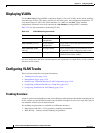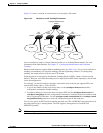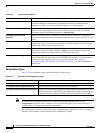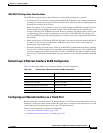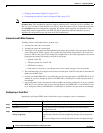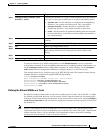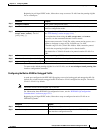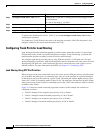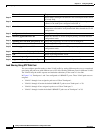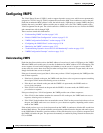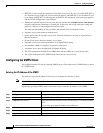
13-24
Catalyst 3750-E and 3560-E Switch Software Configuration Guide
OL-9775-02
Chapter 13 Configuring VLANs
Configuring VLAN Trunks
To return to the default native VLAN, VLAN 1, use the no switchport trunk native vlan interface
configuration command.
If a packet has a VLAN ID that is the same as the outgoing port native VLAN ID, the packet is sent
untagged; otherwise, the switch sends the packet with a tag.
Configuring Trunk Ports for Load Sharing
Load sharing divides the bandwidth supplied by parallel trunks connecting switches. To avoid loops,
STP normally blocks all but one parallel link between switches. Using load sharing, you divide the
traffic between the links according to which VLAN the traffic belongs.
You configure load sharing on trunk ports by using STP port priorities or STP path costs. For load
sharing using STP port priorities, both load-sharing links must be connected to the same switch. For load
sharing using STP path costs, each load-sharing link can be connected to the same switch or to two
different switches. For more information about STP, see Chapter 18, “Configuring STP.”
Load Sharing Using STP Port Priorities
When two ports on the same switch form a loop, the switch uses the STP port priority to decide which
port is enabled and which port is in a blocking state. You can set the priorities on a parallel trunk port
so that the port carries all the traffic for a given VLAN. The trunk port with the higher priority (lower
values) for a VLAN is forwarding traffic for that VLAN. The trunk port with the lower priority (higher
values) for the same VLAN remains in a blocking state for that VLAN. One trunk port sends or receives
all traffic for the VLAN.
Figure 13-3 shows two trunks connecting supported switches. In this example, the switches are
configured as follows:
• VLANs 8 through 10 are assigned a port priority of 16 on Trunk 1.
• VLANs 3 through 6 retain the default port priority of 128 on Trunk 1.
• VLANs 3 through 6 are assigned a port priority of 16 on Trunk 2.
• VLANs 8 through 10 retain the default port priority of 128 on Trunk 2.
Step 3
switchport trunk native vlan vlan-id Configure the VLAN that is sending and receiving untagged traffic
on the trunk port.
For vlan-id, the range is 1 to 4094.
Step 4
end Return to privileged EXEC mode.
Step 5
show interfaces interface-id switchport Verify your entries in the Trunking Native Mode VLAN field.
Step 6
copy running-config startup-config (Optional) Save your entries in the configuration file.
Command Purpose



